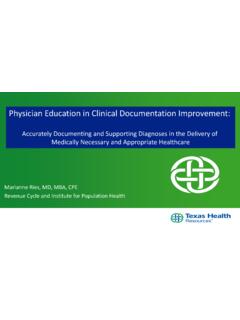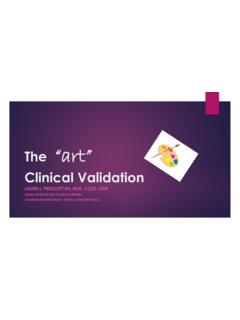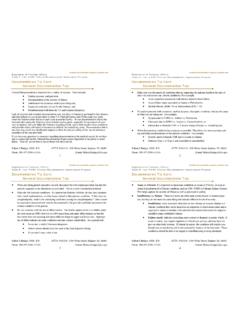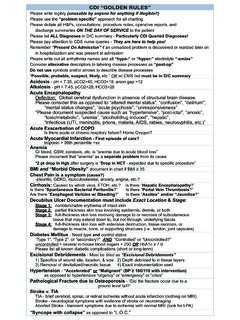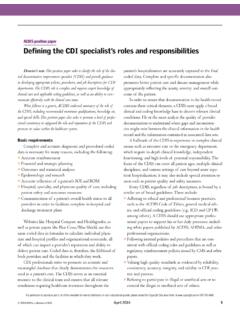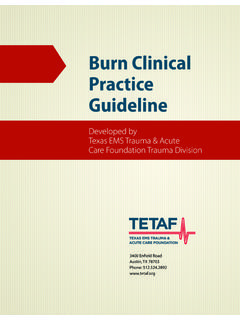Transcription of Outpatient Clinical Documentation Improvement (CDI): An ...
1 WHITE PAPERO utpatient Clinical Documentation Improvement (CDI): An IntroductionzFEATURES Outpatient CDI: Where to begin? ..1 The ED ..3 Ambulatory clinics ..4 Observation services ..6 E/M services ..8 CMS HCCs..10 HCCs for payment vs. quality measure outcomes ..11 References ..13 Summary: In order to facilitate the growth of Outpatient CDI, the ACDIS Advisory Board has written the following white paper. Its goal is to explain what typically constitutes Outpatient CDI, and to discuss ways in which CDI specialists can be leveraged to improve Documentation associated with Outpatient facility and/or provider encounters, ensuring accurate representation of the quality of those services as well as appropriate to a February 2016 survey deployed by the Association of Clinical Documentation Improvement Specialists (ACDIS), only a minority (approximately 10%) of hospitals currently possess an Outpatient CDI program.
2 However, survey data also shows Outpatient CDI is becoming more common; more than 20% of respondents indicated that they plan to cover Outpatient and/or physician services in the next 6 12 months. Clearly, this is an area of growth and what is Outpatient CDI? How is it defined? Some in the industry define outpa-tient CDI as reviewing Documentation in the emergency department (ED) to ensure medical necessity and the solidification of patient status ( , Outpatient or inpa-tient). Others focus on review of local coverage determinations (LCD) or national coverage determinations (NCD), as failure to meet coverage criteria can mean denial of Part B facility and provider payment for expensive Outpatient surgeries or injections/infusions. For those with Medicare Advantage (MA) contracts, their CDI specialists target diagnoses impacting Hierarchical Condition Categories, or HCCs, a payment methodology associated with patients seen in the physician practice setting.
3 This, too, falls under the umbrella of Outpatient CDI is still being defined, and a variety of opportunities exist regarding the review of provider Documentation entered during an Outpatient or provid-er encounter. While this diversity translates into numerous possibilities for CDI expansion, it s also muddied the clarity of CDI s mission in the Outpatient setting, and created unrealistic expectations that a CDI department can cover all of these areas simultaneously especially with the same staffing and training associated with inpatient CDI efforts. This lack of consensus makes it difficult to compare and quantify Outpatient CDI to create practice CDI: Where to begin?Many organizations are recognizing the benefits of CDI efforts that cover doc-umentation challenges found in both the inpatient and Outpatient settings. The same code set, ICD-10-CM, is used to report diagnoses regardless of setting.
4 However, the diagnosis codes reported on an Outpatient or professional services claim have historically been less significant than an inpatient claim. Now, due to recent changes in CMS payment methodologies, including the implementation of May 2016 | 2 2016 by HCPro a division of BLR, Any reproduction is strictly prohibited. For more information, call 877-233-8734 or visit Clinical Documentation Improvement (CDI): An IntroductionMA paid under Medicare Part C and the impact of quality of care measures, out-patient payment represents a larger piece of overall hospital revenue. From 2004 through 2011, for example, Outpatient services per beneficiary grew 34% and inpatient admissions declined by 8% (MedPAC, 2013). Typically, facility Outpatient encounters are reported under the Outpatient prospec-tive payment system (OPPS), which is paid by the Medicare Part B benefit. OPPS claims depend more heavily upon the Healthcare Common Procedure Coding System (HCPCS) code or codes reported on the claim than the diagnosis code, although only as long as the diagnosis code supports medical necessity for the reported service.
5 At a minimum, a CDI specialist working in the Outpatient setting must understand the differences between OPPS methodology and the inpatient prospective payment system (IPPS). If a CDI specialist is planning to expand his or her scope of practice into physician services, he or she should also learn the payment methodologies associated with professional encounters, including the Medicare Physician Fee Schedule and evaluation and management (E/M) comprehensive approach to reviewing Documentation in all settings can help providers and organizations improve the accuracy of risk scores, which are calculated from the diagnoses reported on these claims. Providers are often confused by CDI efforts that limit their reviews to a particular patient population. If CDI reviews all types of encounters, providers are likely to receive consistent feedback on how their Documentation translates into coded data.
6 Additionally, this approach to reviews cultivates a more consistent and comprehensive health record that supports better quality of care and patient outcomes. As mentioned, Outpatient CDI is a very broad concept, encompassing any CDI effort not associated with an inpatient claim. Most hospitals have a significant volume of Outpatient services, and it can be overwhelming to determine where CDI efforts have the greatest impact. According to Chapter 6 of the Medicare Benefit Policy Manual, hospitals provide two distinct types of services to outpatients: services that are diagnostic in nature and other services that aid the physician in the treatment of the patient. One way to determine how to best leverage CDI in an Outpatient setting is through collaboration with other departments impacting the revenue cycle, including health information management or case management.
7 In the inpatient setting, CDI efforts typically measure their impact using the met-rics of improved compliance with quality of care measures or improved financial At a minimum, a CDI specialist working in the Outpatient setting must understand the differences between OPPS methodology and the inpatient prospective payment system (IPPS).May 2016 | 3 2016 by HCPro a division of BLR, Any reproduction is strictly prohibited. For more information, call 877-233-8734 or visit Clinical Documentation Improvement (CDI): An Introductionmeasures. Likewise, Outpatient CDI efforts are typically based upon an underlying target of quality of care or reimbursement. For example, some questions to con-sider include the following: What is your organization s volume of denials for medical necessity of patient status ( , inpatient vs. Outpatient ), which can result in lost reve-nue through auditor recoupment?
8 What is your organization s volume of denials for Outpatient surgical cases due to medical necessity as a covered benefit, which can result in lost revenue? Is your organization part of an accountable care organization (ACO) with a physician practice that participates in MA paid under HCCs, which can affect inpatient quality of care measures? There are many factors to consider when determining where to focus initial Outpatient CDI efforts. This white paper provides a high-level overview of six focus areas in an effort to inform, educate, and offer ideas to organizations considering an expansion of their CDI depart-ment s initiatives. The EDThe ED sees a significantly higher number of encounters than the inpatient setting, and Documentation review must occur very quickly due to quick patient turnaround. When CDI specialists are stationed in the ED, their mission must be clear to all involved to avoid the temptation of using them as another pair of hands to assist with patient care.
9 The CDI specialist reviewing ED encounters should work collaboratively with case management and utilization review rather than replacing their services. Organizations benefit from providing all of these services in the ED setting, and each typically has a different focus. Assigning CDI specialists in the ED can help ensure physician doc-umentation reflects the physician s Clinical judgment, demonstrates medical decision-making, and captures the acuity of the patient, which will lead to fewer medical necessity denials. The ED is also the gateway to inpatient admissions, so clear Documentation regarding the reason for inpatient care can assist with accurate assignment of the principal diagnosis as well as strengthen the medical necessity of the admission. Additionally, admitted patients are typically at their When CDI specialists are stationed in the ED, their mission must be clear to all involved to avoid the temptation of using them as another pair of hands to assist with patient care.
10 May 2016 | 4 2016 by HCPro a division of BLR, Any reproduction is strictly prohibited. For more information, call 877-233-8734 or visit Clinical Documentation Improvement (CDI): An Introductionworst health-wise during their ED treatment, and often the severity of the patient s condition is lost during the admission process. CDI efforts can help preserve and accurately capture the patient s initial presentation. Other benefits of providing CDI services in the ED may include: Accurate capture of facility ED level charges ( , facility E/M) Improved Documentation of infusions and injections Creation of an accurate problem list starting in the ED Improved accuracy of present on admission (POA) indicators Improved patient safety due to a complete and comprehensive health record Addressing and correcting fragmentation or gaps in patient care during the ED encounter Improved Documentation supporting observation services as well as observation start times Proactive capture of data elements associated with quality of care mea-sures that may be specific to the ED setting ( , ED transfer communi-cation) or that also impact the inpatient settingThe role of an Outpatient CDI specialist reviewing ED encounters may differ based upon objectives.
